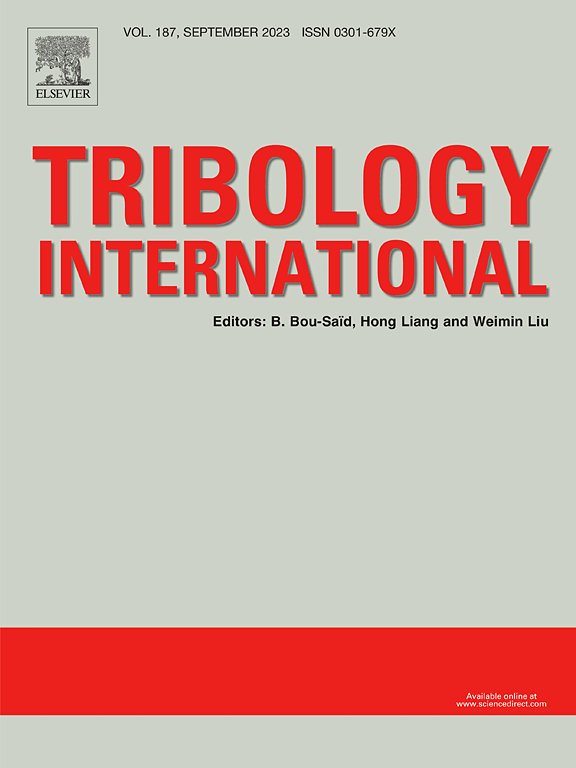旋转环内三维分层流道对干气密封稳态性能的影响
IF 6.1
1区 工程技术
Q1 ENGINEERING, MECHANICAL
引用次数: 0
摘要
针对传统流体动力干气密封由于密闭面空间有限而无法充分优化密封性能的问题,提出了一种新型的三维分层流道干气密封设计,在旋转环内设置分层的泵入或泵出槽,通过轴向孔与端面流体动力槽连接。对比分析了经典螺旋槽密封、分层泵出槽密封、分层泵入槽密封、分层泵进泵出槽密封四种不同流道结构在不同工况下的稳态性能和流场分布。讨论了三层流道密封的性能特点、适用工况以及提高承载能力和控制泄漏的机理,得到了关键结构参数的最优值。结果表明,与经典螺旋槽密封相比,分层泵入槽密封的开启力可以显著提高,但泄漏率大幅增加。分层泵入和泵出槽密封,具有2到3个泵入和泵出孔,表现出性能优势,当转速从10k rpm到30k rpm范围内时,开启力增加了10 %,泄漏率降低了35 %,这表明它可以在广泛的工作条件下提供出色的密封性能。这主要是由于密封端面上的膜压力峰值从动水沟槽根部向泵入孔出口附近沟槽区域径向中部移动,导致沟槽区域内膜压力增加,坝区压力梯度减小。本文章由计算机程序翻译,如有差异,请以英文原文为准。
Effect of the 3D layered flow channels within the rotating ring on the steady-state performance of dry gas seals
To address the issue that the sealing performance of traditional hydrodynamic dry gas seal cannot be fully optimized due to the limited space of the sealing face, a novel dry gas seal design with 3D layered flow channels is proposed, featuring layered pump-in or pump-out grooves inside the rotating ring, connected to the end-face hydrodynamic grooves via axial holes. The steady-state performance and flow field distribution of four different flow channel structures, including classic spiral groove seal, layered pump-out groove seal, layered pump-in groove seal, and layered pump-in and pump-out groove seal, are compared and analyzed under various operating conditions. The performance characteristics, applicable operating conditions, and the mechanism of both load-carrying capacity enhancement and leakage controlling of the three-layered flow channel seals are discussed, and optimal values for key structural parameters are obtained. The results show that, compared to the classic spiral groove seal, the opening force of the layered pump-in groove seal can be significantly increased but at the cost of a substantial increase in leakage rate. The layered pump-in and pump-out groove seal, with two to three pump-in and pump-out holes, demonstrates a performance advantage, achieving a 10 % increase in opening force and a 35 % reduction in leakage rate when rotating speed ranges from 10k rpm to 30k rpm, indicating which can offer excellent sealing performance over a wide range of operating conditions. This is mainly attributed to the increase in film pressure within the groove region and the reduction in pressure gradient in the dam region, resulting from the shift of the film pressure peak on the sealing end face from the groove root of the hydrodynamic grooves toward the radial middle of the groove area near the pump-in hole outlet.
求助全文
通过发布文献求助,成功后即可免费获取论文全文。
去求助
来源期刊

Tribology International
工程技术-工程:机械
CiteScore
10.10
自引率
16.10%
发文量
627
审稿时长
35 days
期刊介绍:
Tribology is the science of rubbing surfaces and contributes to every facet of our everyday life, from live cell friction to engine lubrication and seismology. As such tribology is truly multidisciplinary and this extraordinary breadth of scientific interest is reflected in the scope of Tribology International.
Tribology International seeks to publish original research papers of the highest scientific quality to provide an archival resource for scientists from all backgrounds. Written contributions are invited reporting experimental and modelling studies both in established areas of tribology and emerging fields. Scientific topics include the physics or chemistry of tribo-surfaces, bio-tribology, surface engineering and materials, contact mechanics, nano-tribology, lubricants and hydrodynamic lubrication.
 求助内容:
求助内容: 应助结果提醒方式:
应助结果提醒方式:


